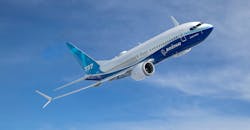FAA Issues New Fine for Boeing 737 MAX
The Federal Aviation Administration proposed a $5.4-million civil penalty against The Boeing Co. for installing unapproved fixtures called "slat tracks" on 178 Boeing 737 MAX aircraft, alleging that Boeing failed to maintain its quality assurance program to ensure suppliers adhered to Federal Aviation regulations.
It's the second FAA penalty for Boeing in just over one month, following a $3.9-million fine set early in December for a series of defective "slat tracks" installed on approximately 133 737 Next-Generation jets.
It's unclear if or how the 737 MAX slat tracks may be implicated in the other safety issue which has idled the aircraft fleet since March 2019. The twin-engine 737 MAX is Boeing's best-selling aircraft, but the 345 jets already delivered to airlines have been grounded for 10 months following two fatal accidents, in October 2018 and March 2019. The crashes killed a total of 346 people, and have been attributed to a faulty flight-control program, called the Maneuvering Characteristics Augmentation System (MCAS). MCAS is an "anti-stall" software meant to counter aerodynamic effects of the redesigned jets’ larger engines.
Among other details resulting from the 737 MAX safety problems is an expanding rift between Boeing and the FAA over the credibility of the company's statements and assertions during the aircraft's pre-certification testing in 2016.
Concerning the FAA's newly proposed penalty, "slat tracks" are fixtures on the leading edge of jet's wings and are used to guide the movement of panels, known as slats, that provide additional lift during takeoff and landing.
The FAA alleges that Boeing failed to adequately oversee its slat-track suppliers to ensure they complied with the company’s quality assurance system, and that this failure resulted in the installation of slat tracks that were weakened by hydrogen embrittlement that occurred during cadmium-titanium plating.
FAA contends that Boeing knowingly submitted aircraft for final FAA airworthiness certification after determining that the parts could not be used due to a failed strength test.
Two suppliers implicated in the 737-NG case are linked again in the current matter. According to FAA, Boeing supplier Southwest United Industries processed the slat tracks, from June 29 to July 1, 2018, and then shipped the components to Spirit AeroSystems Inc., which delivered the parts to Boeing as part of its aerostructure supply agreement.
The FAA further alleges that SUI notified Kencoa Aerospace LLC, on July 6, 2018, that a batch of slat tracks had failed a quality test indicating the presence of hydrogen embrittlement. Kencoa passed that information to Spirit on or about August 3, 2018.
The FAA states that Spirit informed Boeing of the situation on or about September 11, 2018, and proposed that Boeing accept the parts as delivered. Then, FAA claims that on October 9, 2018, Boeing rejected Spirit's proposal and instructed the supplier to submit a Notice of Escapement — a written notification that Boeing instructs suppliers to provide when a nonconformance is identified or suspected to exist on a product already delivered to Boeing.
According to the agency, from August 16 through October 9, 2018, Boeing certified as airworthy approximately 13 Boeing 737 MAX jets potentially equipped with those slat tracks. Between October 10, 2018, and March 10, 2019, Boeing certified an additional 165 potentially affected 737 MAX aircraft as airworthy.
The FAA issued an Airworthiness Directive (AD) on August 15, 2019, mandating inspections of the affected aircraft that were proposed in a June 24, 2019, Boeing service bulletin. (Note that all 737 MAX jets were idled at that time. The AD specified various actions based on the ability to identify the slat tracks.
As with the earlier, 737 NG penalty, Boeing has 30 days after receiving the FAA’s enforcement letter to respond to the agency.
